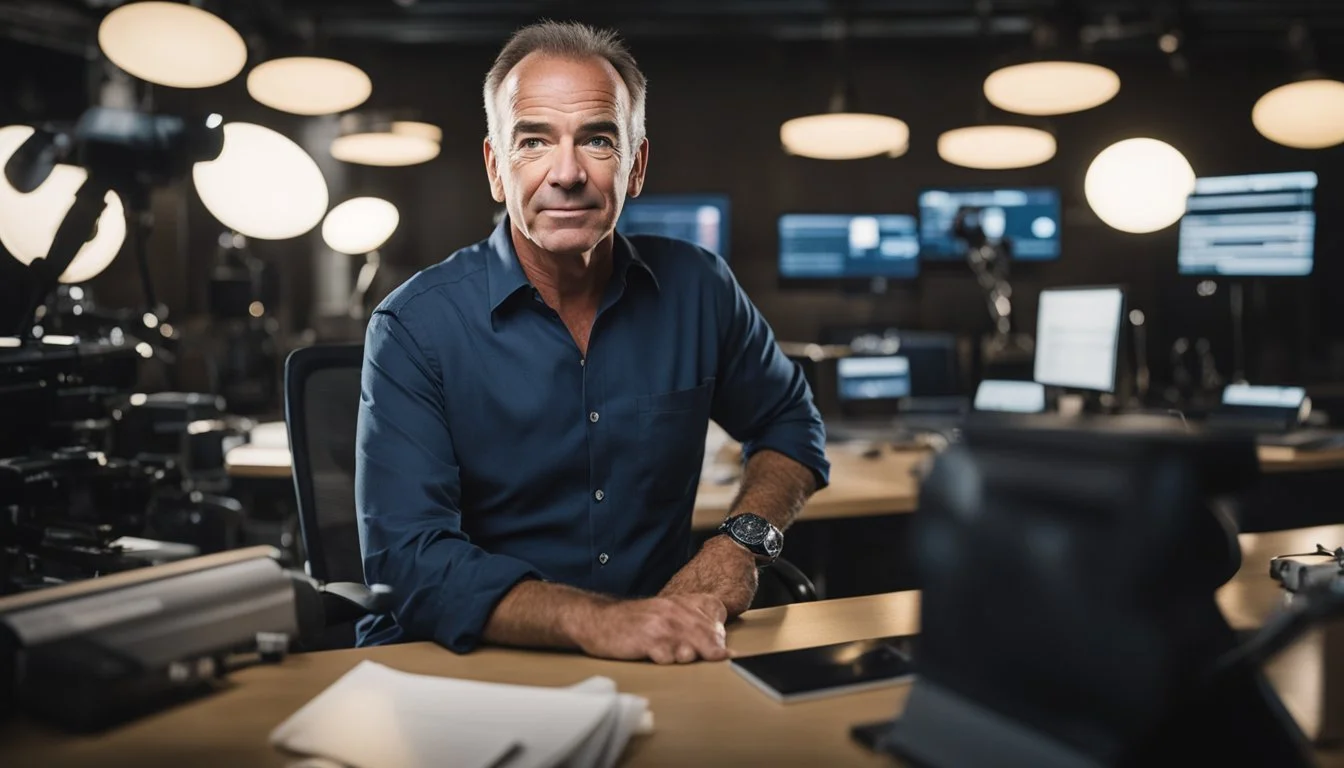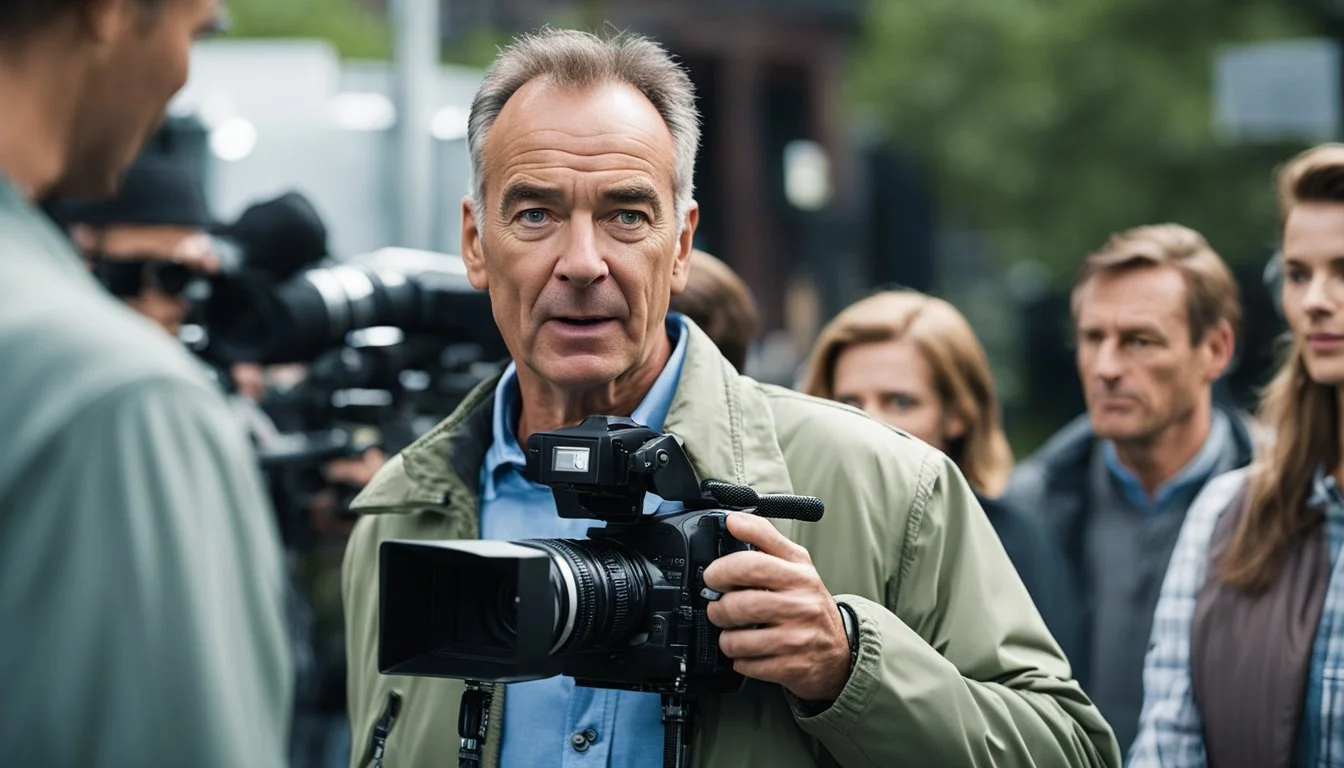Nick Broomfield: Fearless Investigator of Controversial Subjects and Groundbreaking Documentarian
Nick Broomfield stands out in the world of documentary filmmaking with his fearless approach to tackling controversial subjects. Known for his raw, unfiltered storytelling, Broomfield has carved a niche by delving into the lives of diverse personalities, from musicians like Courtney Love to notorious criminals. His unconventional style has sparked important conversations and often challenged societal norms.
Broomfield's unique interviewing style allows him to confront his subjects directly, often leading to unexpected and revealing insights. This approach, combined with his willingness to explore difficult and, at times, dangerous topics, has brought significant attention to issues that might otherwise remain in the shadows.
Despite the controversial nature of his work, Broomfield has maintained a reputation for authenticity and dedication. His films not only entertain but also provoke thought, urging audiences to look deeper into the subjects he portrays. This commitment to truth makes Nick Broomfield a pivotal figure in contemporary documentary cinema.
Biography of Nick Broomfield
Nick Broomfield, born in 1948 in London, is a prominent English documentary filmmaker.
He studied politics and law at Essex University. His first film, Who Cares? (1971), received financial support from the British Film Institute.
Broomfield's approach often includes self-reflective techniques, influencing many filmmakers. Known for his "Direct Cinema" method, he uses non-actors in scripted works.
He ventured into various themes, from entertainment to political issues. His confrontational and immersive style has turned setbacks into strengths.
Nick Broomfield's films include studies of entertainers and cultural figures. His works influenced notable documentarians like Louis Theroux, Michael Moore, and Morgan Spurlock.
Broomfield collaborated with Joan Churchill, a fellow filmmaker. They had a professional and personal relationship, eventually parting ways in the mid-1980s.
Broomfield's contributions to documentary filmmaking span over four decades. He consistently pushes the boundaries of the genre.
Signature Style and Methodology
Nick Broomfield's signature style and methodology are characterized by his active on-screen presence and participatory approach.
He initially started with the Cinema Vérité observational style but later evolved to include more of himself in his documentaries. By appearing on screen as a seemingly disorganized Englishman, he disarms his subjects with a casual and approachable demeanor.
Key Aspects of His Style:
Behind-the-Scenes Footage: Broomfield includes everything from candid conversations to failed interviews, giving a comprehensive view of the filmmaking process.
Passive Interview Technique: He allows subjects to speak freely while persistently pressing them to answer vital questions.
Humanitarian Approach: Influenced by his political science background, he often adopts a compassionate lens, focusing on the human element of controversial topics.
Notable Techniques:
Technique Description On-Screen Presence Broomfield's noticeable participation in his films. Chaos as a Disarming Tool Presents himself in a bumbling manner to relax subjects. Inclusion of Failures Shows unedited, raw, and behind-the-scenes moments. Persistent Questioning Allows subjects to answer but insists on clarity.
By combining these elements, Broomfield constructs documentaries that are both investigative and deeply personal, emphasizing the subjective nature of reality in filmmaking. His style has influenced many, including Louis Theroux, who adopts similar techniques in his own documentaries.
Notable Works
Nick Broomfield has created a series of impactful documentaries that explore complex and often controversial subjects. Each film stands out for its unflinching and raw portrayal of its topics, showcasing Broomfield's fearless approach to storytelling.
Soldier Girls
Soldier Girls (1981) takes an in-depth look at the lives of women undergoing basic training in the U.S. Army. This documentary exposes the intense physical and emotional challenges faced by the female recruits. Broomfield’s ability to capture the raw and often harsh training environment offers viewers an authentic glimpse into the military world from a female perspective.
The Leader, His Driver and the Driver's Wife
In The Leader, His Driver and the Driver's Wife (1991), Broomfield investigates the life of Eugene Terre'Blanche, the leader of a South African white supremacist group. The film provides a critical look at Terre'Blanche and his followers, shedding light on the underlying racial tensions in South Africa during apartheid. Broomfield's probing questions and direct approach make this film a riveting study of extremism.
Aileen Wuornos: The Selling of a Serial Killer
Aileen Wuornos: The Selling of a Serial Killer (1992) delves into the media frenzy surrounding Aileen Wuornos, a convicted female serial killer. Broomfield reveals how Wuornos's story was exploited for financial gain by lawyers, the media, and others involved. Through candid interviews and behind-the-scenes footage, the documentary highlights the dark side of sensationalism and the exploitation of tragedy.
Kurt & Courtney
In Kurt & Courtney (1998), Broomfield explores the relationship between Kurt Cobain and Courtney Love, with a focus on the controversies and conspiracy theories surrounding Cobain's death. The film is known for its provocative content and the legal challenges it faced, particularly from Courtney Love. Broomfield's fearless quest for truth provides an alternate narrative that challenges popular perceptions.
Biggie & Tupac
Biggie & Tupac (2002) investigates the unsolved murders of rap legends Biggie Smalls and Tupac Shakur. Broomfield dives into the conspiracy theories and alleged corruption within law enforcement that may have contributed to the murders remaining unsolved. His interviews with key figures and candid street-level encounters offer a gritty and comprehensive examination of these high-profile cases.
Themes and Subjects
Nick Broomfield's documentaries often explore celebrity culture, crime and corruption, and social and political issues, shedding light on various aspects of humanity by presenting unfiltered and engaging stories.
Celebrity Culture
Broomfield is known for his acute interest in the lives of celebrities. His films, such as "Kurt & Courtney," offer a behind-the-scenes look into the complex and often tumultuous lives of well-known figures.
His approach to celebrity documentaries is distinct. He uses his interviewing skills to uncover personal, and at times controversial, details about his subjects, making these films compelling for viewers.
This focus on celebrity culture not only entertains but also encourages viewers to question the narrative presented by mainstream media.
Crime and Corruption
Many of Broomfield's works delve into crime and corruption. Notable examples include "Aileen: Life and Death of a Serial Killer" and "Biggie and Tupac."
Broomfield's fearless approach to these subjects often places him in contentious situations. He aims to delve beyond surface-level details to reveal the underlying causes and impacts of criminal behavior and systemic corruption.
This theme in his documentaries exposes the dark underbelly of society and often prompts viewers to reflect on broader issues of justice and morality.
Social and Political Issues
Broomfield's interest in social and political issues is evident in films such as "Battle for Haditha" and "Tracking Down Maggie."
These works explore significant socio-political events and figures with a critical eye, aiming to provide insights that are often overlooked.
His documentaries in this genre frequently challenge viewers to reconsider their perspectives on complex issues. By highlighting different viewpoints and experiences, Broomfield contributes to important conversations around social justice and political accountability.
Critical Reception and Impact
Nick Broomfield has cemented his place as a pivotal figure in documentary filmmaking. His unique approach, often involving himself as an on-screen presence, has garnered both acclaim and criticism. By immersing himself directly in the narrative, Broomfield creates a distinct, unfiltered style that resonates with many viewers.
Critics often praise his willingness to tackle controversial topics. His films are known for sparking important conversations, reflecting his fearless nature. Works like Chicken Ranch and Biggie and Tupac showcase his ability to delve into difficult subjects, earning him a reputation as a daring filmmaker.
Some critics, while acknowledging his boldness, question his methods. They suggest that his confrontational style can sometimes overshadow the subjects he aims to highlight. Despite this, there's no denying the significant impact he's had on both audiences and the film industry.
Broomfield's films have been recognized at numerous film festivals worldwide. Accolades and nominations from institutions such as the Sundance Film Festival and the BAFTAs underline his influence in the field of documentary filmmaking.
It's clear that his approach to storytelling has carved a niche for him. He stands out among his peers for his raw, candid method of capturing real-life stories. His career, spanning over four decades, reflects a persistent drive to challenge norms and engage with complex themes.
By continuously pushing the boundaries of documentary filmmaking, Broomfield has not only garnered a dedicated following but also inspired a new generation of filmmakers.
Controversies and Public Perception
Nick Broomfield has never shied away from contentious topics, often stirring public debate. His direct, sometimes confrontational, style draws polarized reactions. Supporters praise his dedication to uncovering truths, regardless of the cost.
Throughout his career, Broomfield has faced criticism for his intrusive techniques. Some interviewees describe his approach as aggressive. Instances like his direct questioning of Courtney Love demonstrate his fearless methodology.
Detractors argue that Broomfield's presence in his films skews the narrative. They suggest his style can overshadow the subjects themselves. This has fueled ongoing debates about objectivity in documentary filmmaking.
Notable controversies include:
His film "Kurt & Courtney" (1998)
"Biggie and Tupac" (2002)
These films probe sensitive cultural events, eliciting strong reactions. Fans and critics alike remain divided.
Despite public contention, Broomfield maintains a significant following. His work often sparks widespread discussion. Each release invites viewers to confront often-uncomfortable realities.
Broomfield's reputation as a bold documentarian remains intact. He occupies a unique place in documentary filmmaking. Through decades of work, he continues to challenge societal norms and provoke thought.
His legacy as a fearless investigator endures, marked by a willingness to venture into controversial territories. His influence extends beyond his films, impacting how stories are told and received.
Collaborations and Influences
Nick Broomfield's career in documentary filmmaking is marked by notable collaborations with other filmmakers and a significant influence from various figures in the field.
Collaborators
Broomfield's work often involves collaborating with other talented cinematographers, editors, and producers. For Chicken Ranch (1983), he worked closely with cinematographer Sandi Sissel to capture the raw, unfiltered moments that defined his signature style. His collaboration with Molly Dineen in the editing phase of several films helped refine his narrative approach, balancing spontaneity with coherent storytelling.
In more contemporary projects, Broomfield has engaged with new voices in the industry, sharing directorial duties and bringing in fresh perspectives. For example, his work on Marianne & Leonard: Words of Love saw collaboration with Marc Hoeferlin in the editing and production processes, adding depth to the emotional impact of the documentary.
Influential Figures in Broomfield's Work
Broomfield has been significantly influenced by predecessors in the documentary field, shaping his approach and methodology. Louis Theroux, notably influenced by Broomfield, adopts a similar interview style that allows subjects to freely express themselves while still being challenged on vital points.
Broomfield's early work, especially his cinema vérité observational style, shows the influence of filmmakers like D.A. Pennebaker and the Maysles brothers, who pioneered direct cinema. His transition to a more personal and confrontational style in documentaries reflects an inspiration from filmmakers like Michael Moore, who also place themselves in the narrative, offering a subjective lens.
In addition, Broomfield's humanitarian approach in films like Ghosts (2006) shows the impact of working with social activists and understanding the power of film to effect change, ultimately helping to raise significant funds for victims' families.
Techniques and Innovations
Nick Broomfield is known for pioneering a distinctive approach in documentary filmmaking. His early works followed the Cinema Vérité style, emphasizing an observational, fly-on-the-wall perspective. This technique allowed viewers to witness events unfold naturally, without interference.
Broomfield's style evolved significantly in the 1980s. By integrating himself into his documentaries, he began to appear on camera. This transition is evident in Chicken Ranch (1983), where he documented interactions and conversations, including behind-the-scenes moments and failed interviews.
One of his notable techniques includes self-reflexivity. Broomfield often addresses the filmmaking process itself, exposing the challenges and dynamics of creating a documentary. This approach adds an extra layer of transparency and authenticity to his work.
Focus on individuals is another hallmark of Broomfield’s films. His subjects range from controversial figures like Aileen Wuornos to celebrities like Kurt Cobain and Courtney Love. This focus allows him to explore broader societal issues through the lens of personal stories.
His commitment to continuous filming captures unguarded moments, revealing deeper truths about his subjects. By filming everything, including the less glamorous aspects of production, Broomfield provides a comprehensive view of his subjects and the filmmaking process.
Technique Description Cinema Vérité Observational style with minimal interference. Self-reflexivity Filmmaker appears on camera and discusses the process. Focus on individuals Highlighting personal stories to explore wider issues. Continuous filming Capturing candid, unfiltered moments.
Nick Broomfield’s innovative techniques have inspired many filmmakers, particularly in the documentary genre.
Comparison With Other Documentarians
Nick Broomfield's style sets him apart from other documentarians. Unlike Michael Moore, who is known for his confrontational and heavily narrated approach, Broomfield maintains a subtle presence in his films. He often appears only for interviews and brief interactions, allowing the subjects and footage to speak for themselves.
Michael Moore:
Confrontational
Heavy narration
Strong personal presence
Nick Broomfield:
Subtle presence
Observational style
Limited personal intrusion
Errol Morris, another well-known documentarian, uses reenactments and unique visual styles to convey his stories. Broomfield, by contrast, prefers a more raw, unfiltered method. He captures everything from behind-the-scenes conversations to failed interviews, making his documentaries feel more spontaneous and authentic.
Errol Morris:
Reenactments
Stylized visuals
Controlled storytelling
Nick Broomfield:
Raw footage
Spontaneous moments
Authentic interactions
Werner Herzog, famous for his poetic narration and philosophical musings, injects his films with his personal worldview. Broomfield diverges from this by letting the subjects drive the narrative. His presence is more observational, providing space for the audience to form their own interpretations.
Werner Herzog:
Poetic narration
Philosophical approach
Personal worldview
Nick Broomfield:
Observational
Letting subjects lead
Minimal personal commentary
Despite these differences, all these documentarians share a commitment to uncovering truth and presenting compelling stories through their unique lenses. Each has carved out a distinct niche within the documentary filmmaking world.
Future Projects and Legacy
Nick Broomfield remains an influential figure in documentary filmmaking. His unique style and fearless approach have secured him a lasting impact on the genre.
Future projects for Broomfield include continued explorations into controversial and challenging subjects. Fans eagerly await his upcoming work which rumor suggests might delve into political corruption or perhaps another music documentary.
His legacy in documentary filmmaking is significant. Broomfield's style, often termed "self-reflexive,” involves the filmmaker himself as part of the narrative. This method offers viewers a unique perspective on the subjects, revealing the complexity and nuances involved.
Key Aspects of Broomfield's Legacy:
Influential Style: Developed a distinct, highly personal approach to documentary storytelling.
Innovative Techniques: Pioneered the "film everything" method, capturing candid moments and behind-the-scenes interactions.
Notable Works: Films like Chicken Ranch and others have set benchmarks in the industry.
Broomfield's influence is seen in the works of many contemporary filmmakers who adopt his innovative techniques. His commitment to shedding light on untold stories and his ability to engage with controversial issues have firmly established his mark in documentary film history.
His work continues to inspire and challenge future generations to push boundaries and explore new narrative forms in filmmaking.








